Are you a Quiet Speculation member?
If not, now is a perfect time to join up! Our powerful tools, breaking-news analysis, and exclusive Discord channel will make sure you stay up to date and ahead of the curve.
When working with data, scale is everything. Just as an area looks very different when using Google Streetview versus Google Maps, the context, meaning, trends, and ultimately the conclusions reached from the data will depend heavily on the scale it's examined on. This is the reason that economics is split between micro and macro level analysis: the former is a zoomed-in study of individual behavior, while the latter is a zoomed-out study of aggregate behavior. We have explored the macro-level analysis of companions in Modern. This week, we'll dive into the micro story.
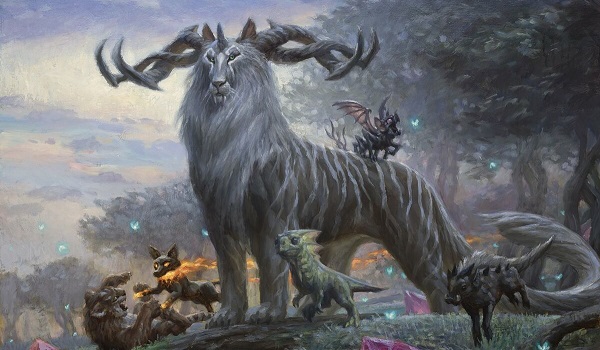
At the conclusion of last week's article, I mentioned that I saw possible trends developing, and that I wanted to keep monitoring them. As shown in that data, the metagame has been substantially changed by the addition of companions. However, the nature of that change is continuing to evolve.
Early indications and assumptions were that Lurrus of the Dream-Den would be the companion for Modern. This has largely proven true, but the picture is growing complicated. Looking at the data on a micro level asks a lot of questions about the effect the companions are having on Modern. And the impact is less clear than before.
The Big Picture
Companions hit Modern in a very big way. The old metagame was focused on midrange decks, particularly those built around Uro, Titan of Nature's Wrath. After Ikoria hit 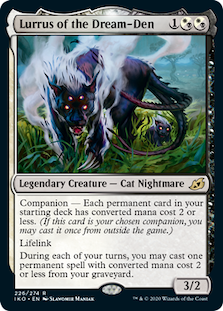 MTGO, the non-black midrange decks fell away and were replaced by Lurrus decks. Specifically, Burn, GBx midrange, Prowess, and Toolbox decks were the top four individual decks by a decent margin. All of them ran Lurrus, though Toolbox sometimes had Zirda instead. Burn and GBx had been tier 1 decks prior to Ikoria, while Prowess was low-Tier 2 and Toolbox was effectively untiered. They create a strong argument that Lurrus is affecting deck viability, and the fact that 66% of decks in the sample used a companion indicated that it was better to have companions than to not. Only Amulet Titan never ran a companion and still placed highly.
MTGO, the non-black midrange decks fell away and were replaced by Lurrus decks. Specifically, Burn, GBx midrange, Prowess, and Toolbox decks were the top four individual decks by a decent margin. All of them ran Lurrus, though Toolbox sometimes had Zirda instead. Burn and GBx had been tier 1 decks prior to Ikoria, while Prowess was low-Tier 2 and Toolbox was effectively untiered. They create a strong argument that Lurrus is affecting deck viability, and the fact that 66% of decks in the sample used a companion indicated that it was better to have companions than to not. Only Amulet Titan never ran a companion and still placed highly.
If one was to just look at that picture, it would be easy to conclude that Lurrus has taken over Modern and is too powerful. However, there's a big caveat to that conclusion: the decks that are doing well with Lurrus now are primarily decks that were already good. Therefore, a more detailed examination is required to see what, if anything, is the actual problem.
Week 1: 4/20-4/25
To do this, I'm going to examine the week-by-week metagame data. My source is the official Wizards MTGO decklist posts. I'm using all the non-League data, since Wizards doesn't curate 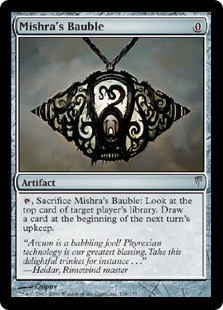 the event lists. Wizards also doesn't reliably post all of the events, so I'm definitely missing a few datapoints. However, there's no guarantee that other sources, namely MTGGoldfish, will have those missing lists, either. The total completeness of the data being slightly less important than source consistency, I'm sticking with Wizards.
the event lists. Wizards also doesn't reliably post all of the events, so I'm definitely missing a few datapoints. However, there's no guarantee that other sources, namely MTGGoldfish, will have those missing lists, either. The total completeness of the data being slightly less important than source consistency, I'm sticking with Wizards.
Also, as with last week, I have grouped some of the results into Other. There are too many decklists to effectively work with otherwise, and the Other category is a good indicator of rogue deck populations. Because I'm working with smaller individual data sets, the Other bar was moved down. With the hundreds of entries in the macro data, five was a good cutoff. Now that each week has less than 200, the line falls down to three. A deck will be listed individually if it has three or more entries in a week and below that it's an Other.
I'll also remind everyone to focus on the metagame percentages rather than the raw numbers. Each week had different populations so the total numbers aren't comparable. Relative populations are comparable, and so that's what I'll be discussing. Also note that the percentages aren't perfect in all cases due to rounding.
Week 1 is the starting position. By itself it doesn't really mean much, other than to show where players' heads were at the start of the metagame. And clearly, players were thinking fiery thoughts. Burn is the most-played individual deck by a fairly wide margin. GBx, which is primarily Jund with some Rock, is in second, with Toolbox a distant third. This is notable particularly because Toolbox wasn't a deck before this week. The Other category is very large, indicating a large amount of experimentation.
Companion Stats
However, it's the companions that we're all actually here for. I recorded every companion that was actually played as a companion (Lurrus saw some maindeck play) as I went through the decklists. I'm also including each companion's metagame share, measured by dividing its total population by the total decks in the weekly sample.
| Companion | Total # | Total Metagame % |
|---|---|---|
| Lurrus | 64 | 51.2 |
| Jegantha | 7 | 5.6 |
| Yorion | 3 | 2.4 |
| Umori | 1 | 0.8 |
| Zirda | 1 | 0.8 |
Roughly 60% of decks had a companion, and for most of them, that companion was Lurrus. When one card is present in half the decks in a sample, there's arguably a problem. On the other hand, this was the first week and Lurrus was the obvious card; it's unclear if this saturation is indicative of actual power, or popularity. I'd expect new cards to see heavy play the first week. It's the trends over the subsequent weeks that actually determine power.
Week 2: 4/26-5/2
Which is an excellent segue into Week 2. With more time to refine and experiment, players had a more accurate picture of Ikoria's actual power and began to adapt accordingly. A note on the data: the Other category dropped significantly in Week 2 and stayed down. However, this isn't an indication of metagame narrowing. Rather, more decks started to cross my threshold, likely due to fluctuations in the weekly populations. The metagame was at least as open as Week 1, and possibly more.
While Burn is still the most played deck, its margin has fallen significantly. As the ~7% drop is far greater than Prowess' 2% gain, this change cannot be a function of players switching decks. I conclude that it instead represents an actual change in deck viability. This is further suggested in GBx losing 6% while still holding second place. The metagame was broadening in Week 2.
Companion Stats
This is reinforced by the companion data. In Week 1, Lurrus was the top cat-like thing and it wasn't close. In Week 2, Lurrus was still the big cat, but not quite so big.
While companions as an overall share of the metagame have increased to ~66.7%, Lurrus' share has fallen by ~8%. The broadening of the metagame on a deck level is reflected in a diversification of companions. It took a week, but the UGx players figured out that they could run Yorion, Sky Nomad just by adding more cantrips, which helps their math problem. Meanwhile, Obosh, Preypiercer was leading a Ponza revival.
Week 3: 5/3-5/9
Week 3 is where trends can actually start to be established. And the general pattern from Week 2 does hold. The metagame continued to broaden relative to Week 1. Other was up by ~3%, though there is one fewer listed deck.
Burn's descent continues. It's no longer top deck, instead tied for 4th place with resurgent UGx decks and Amulet Titan. In its place, Toolbox shot up 3.4%, the largest increase by any deck. GBx has also stabilized and recovered some ground from Week 2. Prowess too held its ground, both relatively and absolutely. It was third with 7.6% in Week 2, and still third with 7.6% in Week 3.
Companion Stats
As seen in Week 2, the companion picture continued to broaden. Lurrus had lost favor relative to the other companions and continued to do so while the overall companion saturation grew. But only slightly.
Companions now represent 69.2% of the metagame, with Lurrus in a mere 41.5% of all decks. However, the rate of change has decreased to ~2% in both cases. This indicates that an equilibrium is being reached and confirming that trend was a primary reason I didn't do the micro analysis before. I wanted to see if the trends continued into Week 4.
Week 4: 5/10-5/16
And then everything got weird. Some trends continued as expected, while a number of others went haywire. Far from indicating that the metagame had started to settle, the Week 4 data suggested greater volatility.
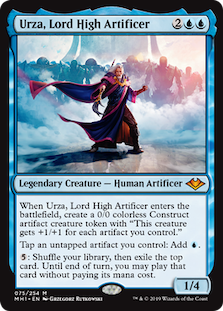 While Burn has continued its steady decline, Prowess has shot up to the top of the metagame, gaining 8% in a week. At the same time, Toolbox has crashed, losing 8%. While I have no proof, I can't help feeling that the two are linked. Many Prowess decks run Gut Shot, and Toolbox is full of X/1 creatures it needs to get the ball rolling. Prowess was able to effectively disrupt the top deck and race it. It's a logical conclusion, but I have no evidence to prove it.
While Burn has continued its steady decline, Prowess has shot up to the top of the metagame, gaining 8% in a week. At the same time, Toolbox has crashed, losing 8%. While I have no proof, I can't help feeling that the two are linked. Many Prowess decks run Gut Shot, and Toolbox is full of X/1 creatures it needs to get the ball rolling. Prowess was able to effectively disrupt the top deck and race it. It's a logical conclusion, but I have no evidence to prove it.
Meanwhile, the UGx decks that were looking to recover from their week-one pounding have crashed again, with Temur Urza failing to appear. Some of this may be changing decks. There were a number of Temur Scapeshift decks using Urza to fill out their lists to run Yorion. These lists are strategically distinct from Temur Urza lists, and even if I did count them, their numbers are still far below the previous week's. Some of this could be linked to the rise of Ponza, which had been preying on UGx in the old meta and has gained ~3% in a week.
Companion Stats
The companion picture, meanwhile, is getting more complex.
| Companion | Total # | Total Metagame % |
|---|---|---|
| Lurrus | 72 | 43.1 |
| Yorion | 18 | 10.8 |
| Obosh | 12 | 7.2 |
| Jegantha | 8 | 4.8 |
| Kaheera | 2 | 1.2 |
| Gyruda | 1 | 0.6 |
| Zirda | 1 | 0.6 |
 The trend appears to have reversed. Lurrus is up 1.6% from the previous week, but companions overall are down by ~1%. This is a very small fluctuation and may represent normal variance rather than a genuine change, but it does still suggest that companions have achieved their maximum saturation. Yorion fell off by ~7% while Obosh surged by ~3%, which suggests that players are continuing to experiment with their decks and the metagame.
The trend appears to have reversed. Lurrus is up 1.6% from the previous week, but companions overall are down by ~1%. This is a very small fluctuation and may represent normal variance rather than a genuine change, but it does still suggest that companions have achieved their maximum saturation. Yorion fell off by ~7% while Obosh surged by ~3%, which suggests that players are continuing to experiment with their decks and the metagame.
The number of represented companions remains seven, but the composition has changed. Kaheera, the Orphanguard makes its debut, but not as a lord; instead, several UW decks decided to go creatureless so that they always have Kaheera as a threat. I question whether this will be a sustained trend or just a flavor of the week.
Trending Now
It can be daunting to try and deduce anything meaningful from tables of data. To that end, here's the visuals on companion in the Modern meta.
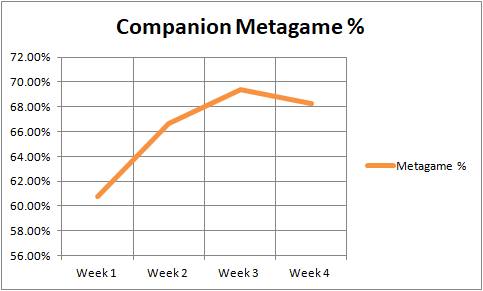
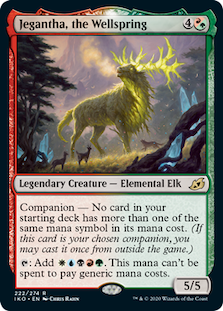 Companion started out with a very high metagame percentage, as Lurrus was expected to be very strong. The set was just out, but only one copy of Lurrus was needed per deck. Thus, once the supply issues were overcome, Lurrus was and has been readily available.
Companion started out with a very high metagame percentage, as Lurrus was expected to be very strong. The set was just out, but only one copy of Lurrus was needed per deck. Thus, once the supply issues were overcome, Lurrus was and has been readily available.
What's significant is that its overall gain has been muted. Companions have gained ~8% metagame share over the sample time, which would be very significant had it started out low. However, when ~51% of the field was running Lurrus from the get go, the increase is less impressive. This is complicated when looking at the individual companions.
Who's My Best Buddy?
Again, Lurrus was billed and expected to be the premier companion. And it has been. However, what that means has changed dramatically. Initially, Lurrus was the companion in Modern, and it looked like it was necessary to have Lurrus specifically to win in Modern. That narrative has weakened, and now it looks like Lurrus is merely the best companion rather than the paragon.
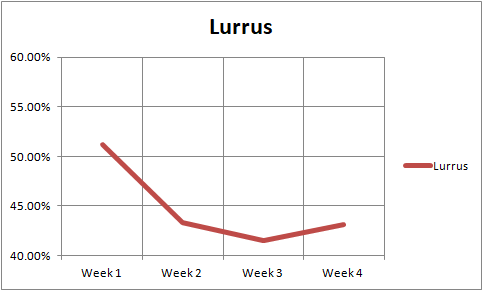
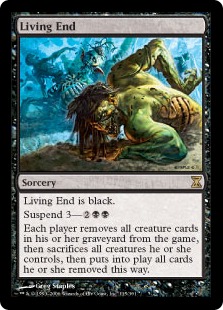 It's no exaggeration to say Lurrus has fallen off. It's down 8.1% from Week 1 despite a small rebound in Week 4. Some of the fall off must be linked to the rise in other companion decks. Part may be that Lurrus isn't quite as impressive as billed for many players. And then there's metagame adaptation.
It's no exaggeration to say Lurrus has fallen off. It's down 8.1% from Week 1 despite a small rebound in Week 4. Some of the fall off must be linked to the rise in other companion decks. Part may be that Lurrus isn't quite as impressive as billed for many players. And then there's metagame adaptation.
Lurrus being a Modern card was fairly obvious, but the other companions weren't so clear-cut, and now they're rising. The only companion that hasn't shown up in the data so far is Keruga, the Macrosage. This isn't a format where decks can just not play anything for the first few turns. The only way around this restriction is cycling decks, and Living End isn't exactly tearing it up. However, of the other non-Lurrus companions, only some are having a real impact. And the picture that emerges when considering only those decks that consistently show up week-by-week and have appreciable metagame impacts is very cloudy.
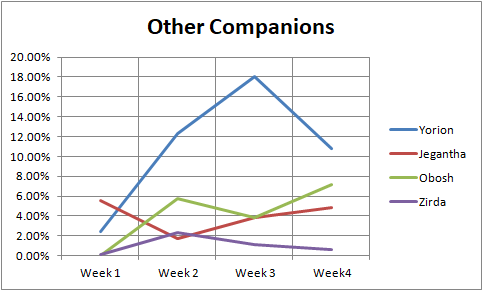
All of the non-Lurrus companions have gained metagame share since 4/20. However, the only one that isn't down from its peak is Obosh, the Preypiercer. And Zirda is just above its starting position. Yorion fell off significantly last week while Obosh was rising. Again, this may a predator/prey relationship if the old metagame dynamics are to be believed. In any case, it seems that outside Lurrus, players are still figuring out the companions and it isn't clear what, if any, place they have.
Top Tier Evolution
Meanwhile, the actual tier list isn't any clearer. I identified Burn, GBx, Prowess, UGx, Amulet Titan and Ponza as the big decks previously. That picture is obvious when taken all together, but when looked at on an individual level, there's far more happening that I'd anticipated.
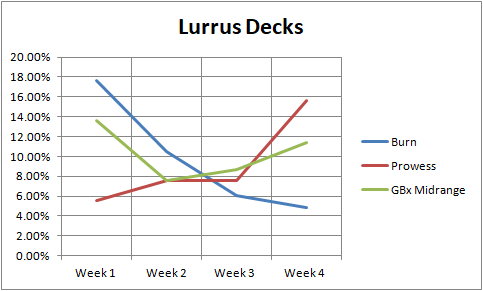
Burn has been on a steep decline since 4/20. GBx has shown a steady recovery since 4/26, while Prowess has skyrocketed into top tier. In other words, there is no consistency in results for the Lurrus decks. Having the companion isn't a predictor of success, and the old metagame forces are still active. This is further demonstrated when considering the non-Lurrus decks.
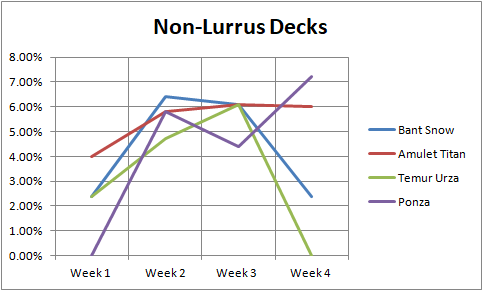
The only companionless deck is Amulet Titan, and it just keeps chugging along. All the other decks show high volatility. Temur Urza has crashed out, Bant Snow is back where it started, and Ponza had a great week. There is little to indicate that the companions themselves are affecting viability. Given the high variance in the high-placing decks (including the Lurrus decks) the question of correlation or causation remains murky.
Companion Viability
To examine that question, I looked at the decks I consider companion-dependent. These are decks with either actually none or no appreciable (>1%) impact on the pre-Ikoria metagame, but did show up in the post-Ikoria data. The argument they make is for correlation, not causation.
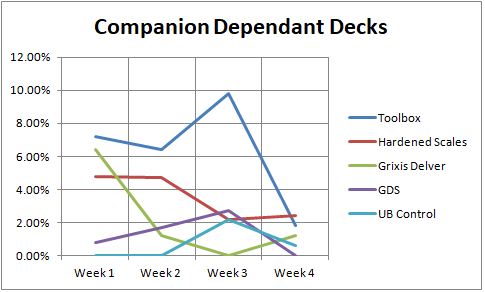
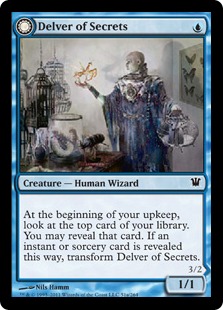 Every single deck is down from its peak. Last week, Toolbox fell precipitously, while Grixis Death's Shadow disappeared. Grixis Delver failed to place Week 3 and just snuck into Week 4. Hardened Scales is sticking around, but the evidence does not support it being a serious contender in the overall metagame.
Every single deck is down from its peak. Last week, Toolbox fell precipitously, while Grixis Death's Shadow disappeared. Grixis Delver failed to place Week 3 and just snuck into Week 4. Hardened Scales is sticking around, but the evidence does not support it being a serious contender in the overall metagame.
None of these decks held any sort of metagame share before companions. Adopting companions did make them considerations, but they haven't remained as such. My takeaway from this result is that companion does not change deck viability. A power or consistency boost doesn't necessarily improve a fundamentally weak strategy enough to compete with the proven decks.
A Complicated World
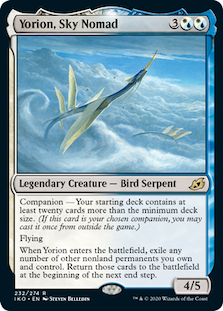 Companions are saturating the Modern metagame. There's early indication that the saturation has peaked. There is evidence that companions are best used in otherwise strong and highly-tiered decks and that they aren't affecting overall metagame diversity. However, the metagame remains highly volatile, and is therefore still developing.
Companions are saturating the Modern metagame. There's early indication that the saturation has peaked. There is evidence that companions are best used in otherwise strong and highly-tiered decks and that they aren't affecting overall metagame diversity. However, the metagame remains highly volatile, and is therefore still developing.
I think this last point is why Wizards hasn't taken action on companions in Modern yet. With all the volatility, I can't point to any one deck, or even conclusively point to Lurrus, as being an actual problem. It's the overall environment that looks unhealthy. By the traditional metrics, Modern is perfectly fine. There's no one deck that is overpowering or warping the format. Diversity is similarly unaffected. The saturation of the companion mechanic is the concern.
Given what was said in the banning announcement, I believe that Wizards is hoping that companion can be salvaged. A lot of effort went into the cards, and as a flagship mechanic, they don't want to simply throw it away. They're looking at the data and seeing the format volatility, and they also have actual win rates, waiting for stronger trends to emerge. The hope is that the data justifies a targeted ban on a single companion or card. I'm growing increasingly skeptical of the possibility in light of my data showing that companion representation is diversifying. I think we're looking at either a sweeping ban or a complete rules reworking in the next month.





Honestly, they should just pack them up and ban them all, eat the loss and count it as a learning experience. R&D should, by now, be sufficiently humbled and maybe, just maybe we’ll see a return to safety-first design. People may have thought that Ixalan was boring, but I’ll take boring over broken seven days a week, and twice on Sundays.
That said, I do think that we’ll see a change to the companion rules first. Their ban announcement seemed to imply that they are open to trying it. Lurrus will still likely get whacked with the hammer either way, ut what happens with the others, particularly Yorion, will be very interesting. It’s a shame that this was all such a poop show, because Yorion’s deck-building requirement is genuinely interesting, and brings something unique to the format. Will he still be worth playing under the Davis’ rule? I don’t know. Will Humans still run Jegantha if Wizards decides to change the rules? I don’t think so, but who knows?
Whatever they decide, I hope that it happens sooner rather than later. I’m sooooo over MTG right now, two years of broken card after broken card is just frustrating and it’s a massive turn off to any new product Wizards releases. I haven’t purchased a single Ikoria product, apart from one digital Lurrus for Merfolk, which I am going to move the instant they announce the next ban announcement. The only saving grace the game has had for me is Old School. That format is a genuine joy and I dearly wish Wizards would program it in to Arena.